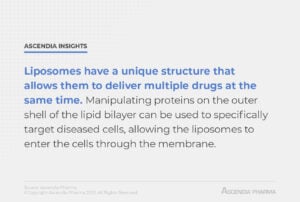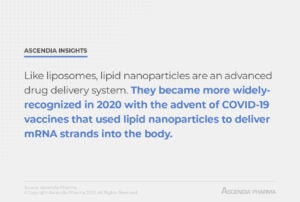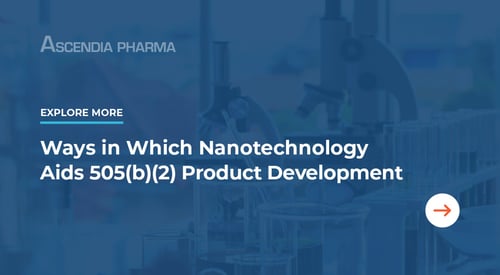Liposome vs. Lipid Nanoparticle: What’s the Difference?
It’s common for liposomes to be called lipid nanoparticles, but strictly speaking, this isn’t correct. Liposomes and lipid nanoparticles are two different types of lipid-based delivery, and while there is some overlap, they have different structures and stability.
In this article, we’ll discuss the difference between nanoparticles and liposomes, along with their applications in medicine.

Lipid-Based Drug Delivery: A Quick Primer
Both liposomes and liquid nanoparticles fall under the umbrella of lipid-based delivery. This family includes:
• Liposomes – These are a supramolecular aggregate made from amphipathic molecules (often phospholipids) that are formed in an aqueous phase. They can range from tens of nanometers to hundreds of micrometers in size.
• Single emulsions – Single emulsions use surfactants to suspend drops of oil in water or drops of water in oil.
• Micelles – These are particles made up of surfactants that have cores consisting of lipophilic tails.
• Nanoemulsions – Nanoemulsions are particles that have an oil core; this core is surrounded by a layer of surfactant.
• Solid lipid nanoparticles – These particles have a solid wax or lipid core surrounded by a layer of surfactants.
• Nanostructured lipid carriers – Also known as NLCs, these particles have a blend of solid and liquid lipids at the core.
As pharmaceutical formulation and nanoparticle technology advance, lipid-based delivery mechanisms continue to decrease in size. Smaller particles mean improvement in suspension, shelf life, stability, and efficacy, and as such, lipid-based drug delivery systems hold promise for the future, particularly when it comes to difficult to formulate and poorly water-soluble drugs.
>> Related Read – Developing an Effective Lipid Nanoparticle Formulation Process for Small Molecule and Biologicals Delivery
What Is a Liposome?
Liposomes were first described in the mid-1960s, and they continue to be a drug delivery system of choice in today’s pharmaceutical industry. They produce few adverse reactions because of their superior biocompatibility, and their amphiphilic structure means they can encapsulate hydrophilic and hydrophobic APIs.
Liposomes are created from cholesterol and natural non-toxic phospholipids, and advances in pharmaceutical formulation and development have enabled them to target specific sites within the body; by treating liposome surfaces with certain proteins, they can be developed to bind to specific target cells in order to treat disease. This is referred to as liposomal encapsulation technology (LET); a drug is coated in liposomes that are designed to break down only when in contact with the targeted organ, gland, or system.
Another advantage of liposomes is that they mimic biological membranes, which allow them to evade attack from the body’s immune system, giving them more time to reach their target. Their ability to solubilize lipophilic molecules and modulate the biodistribution and pharmacokinetics of the API mean liposomes have fewer side effects and improved safety over many other drug delivery methods.

Structurally, liposomes have a noteworthy vesicular structure with a lipid bilayer that forms a sphere to encapsulate an aqueous phase. This is what gives liposomes the ability to deliver both hydrophilic and lipophilic APIs—hydrophilic APIs can be transported in the aqueous compartment, while lipophilic APIs can be transported in the lipid bilayer.
Their unique structure also allows liposomes to deliver multiple drugs at the same time, as they protect APIs from breaking down before reaching their target. Manipulating proteins on the outer shell of the lipid bilayer can be used to specifically target diseased cells, allowing the liposomes to enter the cells through the membrane.
Liposomes are commonly formulated as sterile injectables that deliver a drug into the bloodstream. As the lipid enclosures break down, either within or outside of cells, the API is released. Formulations designed to be released inside cells may be made with pH-sensitive lipids, photosensitivity, or thermosensitivity.
Types of Liposomes
There are four types of liposomal delivery systems: conventional liposomes, sterically-stabilized liposomes, ligand-targeted liposomes, and liposomes that combine these features.
Conventional liposomes were the first liposomes developed, but their rapid elimination from the bloodstream proved to be an obstacle, leading to the development of sterically-stabilized liposomes, which circulate longer in the bloodstream thanks to a steric barrier. Ligand-targeted liposomes are another advance in liposome technology, as they allow for site-specific drug delivery.
Manufacturing Liposomes
Some of the most common ways to prepare liposomes include:
• Sonication – Sonication is the most widely-used technique for dispersing lipids. A bath sonicator or probe sonicator produces liposomes passively. This method is limited in its ability to encapsulate large molecules, and both internal molecules and phospholipids may be vulnerable to degradation.
• French pressure cell – This extrusion method pushes multilamellar vesicles through a small opening to disperse lipids. It requires high temperatures and has a limited working volume, but it results in more stability and larger liposomes.
• Freeze-thawed liposomes – In this process, small unilamellar vesicles are briefly frozen, then slowly thawed to disperse the lipids and form large unilamellar vesicles.
While these are the most common methods of manufacturing liposomes, there are a number of others, including micro-emulsification, lipid film hydration, and membrane extrusion.
>> Related Read – Understanding Emulsion Formulation

What Is a Lipid Nanoparticle?
Lipid nanoparticles (or solid lipid nanoparticles) are simply nanoparticles that are composed of lipids. Like liposomes, lipid nanoparticles are an advanced drug delivery system; they were first approved in 2018, and became more widely-recognized in 2020 with the advent of COVID-19 vaccines that used lipid nanoparticles to deliver mRNA strands into the body.
Solid lipid nanoparticles are usually spheres, and their diameter typically ranges between 10 and 1000 nanometers. They have a core matrix of solid lipids; this matrix can solubilize lipophilic molecules. The core is stabilized by surfactants, with the type used depending on the application.
Lipid nanoparticles are non-toxic, easy to manufacture, and biocompatible; they can be used to deliver both small molecule drugs and advanced biologics. These characteristics, combined with their pharmacokinetic profile, make liquid nanoparticles an ideal choice for treating any disease, and cancer in particular. Nanoparticles have also shown promise as antimicrobials, with the potential to overcome drug resistance.
With more complex drugs in the development pipeline, lipid nanoparticles offer a means of overcoming some of the obstacles in these difficult to formulate drugs. Oligonucleotides like RNA, mRNA, siRNA, and DNA are receiving increasing attention for their ability to fight disease at the genetic level, but other drug delivery methods leave them vulnerable to breakdown in the body; lipid nanoparticles are well-suited to delivering oligonucleotides because of their high degree of stability.
While liposomes are an established technology, solid lipid nanoparticles are still considered an emerging field within lipid nanotechnology. They offer a new prototype for drug delivery, with increased bioavailability, lower cytotoxicity, improved penetration, reduced immunogenicity, and greater potential for targeted API delivery.
>> Related Read – Ways in Which Nanotechnology Aids 505(b)(2) Product Development
Manufacturing Lipid Nanoparticles
Lipid nanoparticles are a new technology, and manufacturing processes are still being established. Dedicated production equipment isn’t yet available for purchase, which means manufacturers must find suppliers that can design custom solutions.
As an example, lipid nanoparticle delivery systems for nucleic acid formulations were initially produced by thin-film hydration or reverse-phase evaporation, but it’s now common for lipid nanoparticle-mRNA formulations to be manufactured via rapid mixing with an ethanol phase and aqueous phase mixed under specific pH and flow rate conditions. This formulation is purified to remove organic solvents and residual components, then the final mRNA concentration can be increased by enrichment.
With pharmaceutical companies eager to get lipid nanoparticles to market, finding a solution that doesn’t involve the use of solvents is critical, as solvents must be removed, which is difficult and time-consuming.
The Difference Between Nanoparticles and Liposomes
It’s easy to see why solid lipid nanoparticles and liposomes are so often conflated; the two are quite similar, and certainly have more similarities than differences. Both lipid nanoparticles and liposomes are nano formulations that excel in delivering poorly water soluble and other difficult to formulate drugs; they also protect their APIs with an outer bilayer of lipids.
Where the two differ is in the fact that lipid nanoparticles have many different forms. Lipid nanoparticles are liposome-like structures, and they can be used to encapsulate a number of different nucleic acids. Liposomes have one or more rings of lipid bilayer surrounding an aqueous pocket, but lipid nanoparticles usually only have a single phospholipid outer layer that encapsulates the interior, which may be non-aqueous.
Liposomes were essentially an early, simpler version of lipid nanoparticles, but they continue to be useful even as the next generation of lipid nanocarriers gains popularity. They’re valued for their ability to carry both hydrophobic and hydrophilic molecules, nucleic acids, and proteins, but they call for complex production methods that are difficult to scale. Solid lipid nanoparticles build upon liposome technology, but their solid lipid bilayers will make them easier to manufacture at scale once equipment is widely available, and it also makes them more stable.
>> Related Read – Considerations in Development and Manufacturing of Complex Injectables for Early Phase Studies
Partnering With Ascendia for Liposome and Lipid Nanoparticle Development and Manufacturing
Ascendia is at the forefront when it comes to using liposomes and lipid nanoparticles as drug delivery systems.
Our team specializes in the application of nanotechnology solutions for low bioavailability, poorly soluble, and other difficult to formulate drugs, developing novel pharmaceutical products in the process. Ascendia has the ability to prepare nanoparticle formulations by bead-milling, microfluidization, and homogenization; these formulations can be incorporated into solid dosage forms or suspended for injection.
In addition to nanoparticles, we have the equipment and know-how to create self-emulsifying lipid systems, dispersed amorphous systems, and nano-emulsions to formulate unique dosage forms that can be administered orally, topically, or parenterally.
To learn more about partnering with Ascendia, contact us today.



